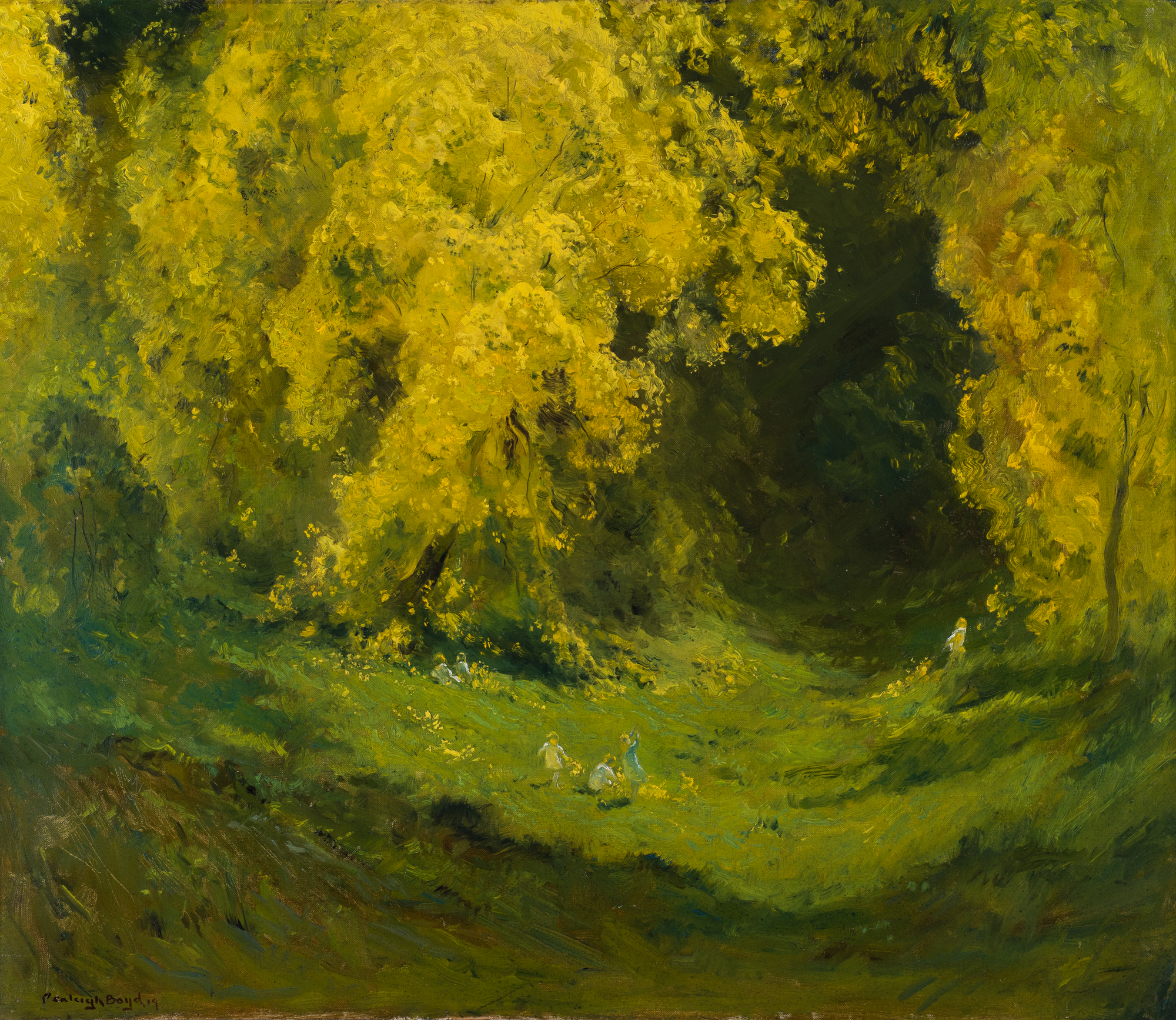Smith on Boyd
In this erudite reflection, Geoffrey Smith writes about Penleigh Boyd. Smith weaves Boyd’s biography with his rousing use of wattle, reminding us of the symbolic role wattle played in Australian in the lead up to Federation and beyond to the post war years.

Smith on Boyd
During his lifetime, and in the decades following his premature death at the age of thirty-three, Penleigh Boyd received the greatest recognition for his evocative depictions of Australian wattle. These images – all showing golden blossom on the banks of the Yarra River – reveal the artist’s fascination with emblems that resonated with deep-felt personal and national meaning and sentiment.
Acacia pycnantha, or golden wattle, had been recognised as an important motif in the lead up to Australia’s Federation in 1901. During this period, public interest in the Australian environment was awakened and the search for a national identity forged a desire and requirement for national symbols. Founded in Victoria in 1899, The Wattle Club promoted an annual Wattle Day on 7 September, to coincide with the arrival of spring, and to encourage recognition of the flowers as a symbol of patriotism. By 1912 it was considered Australia’s national flower and incorporated into the design of armorial bearings of the Commonwealth of Australia. The golden wattle was formally proclaimed Australia’s floral emblem on 1 September 1988. The symbolism of wattle gained in significance during the First World War, when Wattle Day badges were sold to raise funds for the war effort. The potency of wattle was most pronounced in the popular wartime song When Blood will Stain the Wattle.
Penleigh Boyd’s life and art was inextricably connected to the First World War. Serving with the Australian Imperial Forces in France, he was badly gassed at Ypres in September 1917, and convalesced in England, before returning home to Melbourne in March 1918. Although surviving his wartime experiences, Boyd’s death in a motor car accident in 1923, inadvertently aligned him to the ‘lost generation’ of young men killed in action, his loss mourned by the art and wider community. (1)
Boyd’s most celebrated wattle subject, The Breath of Spring (1919, National Gallery of Victoria, Melbourne), represented the artist’s most important treatment of the theme to date. The ‘squandered gold of the loaded wattle’ (2) that floods the composition – massed on the riverbank and reflected in the still water represented a tour de force in Australian landscape painting. Critics were ecstatic in their praise: ‘The glorious blaze of the golden wattle dominates the canvas – dominates the entire surroundings in fact, for everything adjacent looks flat and pointless in contradistinction. No man has painted the golden profusion quite so convincingly – No, not even Streeton.’ (3) Immediately acquired by the Felton Bequest for the National Gallery of Victoria (the first work by Boyd to enter a public collection), The Breath of Spring provoked much discussion, for and against, and when hung in the Gallery, became known as ‘the scrambled egg painting.’ (4)
Penleigh Boyd’s images of blossoming wattle offer a reaffirmation of the beauty, purity and truth found in nature. These harmonious and peaceful landscapes – bathed in an almost ethereal light – provide a contrast between the beauty of the natural world and the sinister face of war. Boyd’s home at Warrandyte, nestled on the Yarra River twenty-four kilometres north-east of Melbourne, remained intact as an environment which ‘could induce the atmosphere of tranquil detachment from external and material things which I believe is considered necessary for the production of great art.’ (5)
The images of wattle produced by Boyd represent a pinnacle of his career and a significant moment in the history and development of Australian art. Imbued with a strong sense of place and location, his paintings captured a feature of the landscape – wattle – that together with the gum-tree, mountain-range, river, haystack, sheep and cattle, assisted in the creation of a national iconography. In the aftermath of war, Boyd’s imagery contained no threats or uncontrollable forces, and represented something universal, stable and permanent. The power and purity of the wattle endowed the landscape with an almost sacred significance.
‘Spring suggests life & vigour & ambition’, Boyd wrote to his wife from the Western Front, ‘while, Autumn suggests Achievement & Age & Satisfaction.’ (6) Wattle became Boyd’s supreme symbol of spring, trumpeting its arrival and celebrating its vitality and optimism.
Spring Fantasy 1919, presented to Castlemaine Art Museum by the artist in 1921, remains for me a personal highlight of CAM’s collection; a deeply tender and sensitive interpretation of an everyday scene by an artist whose brilliant career was curtailed by his tragic death at the age of thirty-three.
Geoffrey Smith
September 2020
(1) Indeed as early as 1924, he was described as ‘the late Penleigh Boyd, who was killed in the war’, see The Daily Mail, London, 24 June 1924
(2) James MacDonald, The Landscapes of Penleigh Boyd, Alexander McCubbin, Melbourne, 1920, n.p.
(3) John Shirlow, ‘Australian Artists: Penleigh Boyd’, The Herald, Melbourne, 30 October 1920, p. 4
(4) Arnold Shore, ‘Penleigh Boyd: An Artist Cut Off in His Prime’, The Age, Melbourne, 5 March 1960, p. 18
(5) Penleigh Boyd, Salvage: Pictures and Impressions of the Western Front, The British Australasian, London, 1918, reprinted Australian War Memorial Facsimile Editions, Canberra, 1983, n.p.
(6) ibid., n.p.